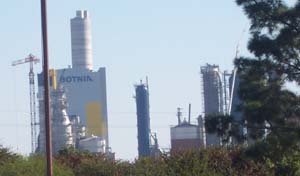 |
Pulp
mills in Uruguay |
| Uruguay-Argentina:
A huge demonstration against pulp mills
Uruguay, a territory blessed by a profuse hydrological network, with soils extending over part of the Guaraní aquifer – one of the largest aquifers in the world – bears the “natural country” logo. This could well be so, with its vast prairies and rich productive soils, with an abundance of water, scant industrial development and low population density. However, this landscape that many might consider as a sort of paradise is being threatened. In fact, before handing over power in March 2005, the outgoing government authorized the installation of two enormous pulp mills on the banks of the Uruguay River, a river that runs along the whole western frontier of the country, separating it from its neighbour, Argentina, which shares the river with Uruguay. This authorization is being questioned as a result of the opposition of Uruguayans and Argentinians from the Province of Entre Rios, neighbouring the zone where the Spanish company ENCE and the Swedish-Finnish company Botnia /UPM/Kymmene are to be established. Both peoples have joined forces to prevent their common river, the “River of the Painted Birds” (the meaning of “Uruguay” in the Guaraní language), from becoming the “River of the Dead Fish.” The fact is that the activity of the two pulp mills is expected to reach gigantic dimensions and therefore, the risk of contamination is enormous. The expression of regional integration is best found in the Socio-environmental Network that brings together social and environmental organizations and the population at large both in Uruguay and Argentina. The network has brought together those who are willing to resist the imposition of contaminating mega-projects in these regions weighed down by indebtedness, unemployment and despair. In the year 2003, the members of the Network attempted to express their opposition to the pulp mills by holding a demonstration half way across the international bridge that unites the Uruguayan and Argentine coasts, near the city of Fray Bentos. The Uruguayan authorities did not allow this action to take place and on the Argentine side, only a small delegation was authorized to cross the bridge. In spite of that, this until then practically invisible issue began to take on public status and became a matter for the Ministries of Foreign Affairs (see WRM Bulletin Nº 75). Since then, more and more people have become involved in the struggle and the strength of two peoples convinced about the justice of their cause has increased. Voices have multiplied by thousands and thousands, becoming an unstoppable human river to make the projected encounter on the bridge possible. April 30, 2005 marked a peak in this struggle. Hundreds became thousands and thousands, the international bridge turned into an enormous human column, extending on the Argentine side beyond sight, under the shade of Uruguayan and Argentine flags (see photos in http://www.guayubira.org.uy/celulosa/abrazofotos.html). Songs and national anthems were sung, palms beat on the drums and hands carried banners telling the world that these peoples say YES TO LIFE and for this reason do not want the pulp mills. Under the bridge, launches and small boats bearing flags covered the tranquil waters of the Uruguay River. As a framework for this historic day, the landscape seemed to mark the way: a blue and limpid sky, with no toxic and bad smelling gases; golden sands along the coast where the green woods sweep down to the river, with no effluents and black sludge, and no dead fish. Emotion, decision. Now the struggle has been placed on official agendas and on the headlines of the mass media: radio stations, television channels and the press. The installation of pulp mills was one of the items on the agenda of the Uruguayan President Vazquez and the Argentine President Kirchner at the presidential meeting held in Buenos Aires on 5 May. On that occasion, the Argentine President asked for the installation of the works to be halted and for university technicians to study the possible effects that this installation would have on the Argentine coast. Vazquez stated that he had received this situation as a fait accompli from the past government and that the construction of the pulp mills could not be halted, but apparently agreed on an investigation to be carried out by academic circles. Hundreds of demonstrators and buses flying Argentine and Uruguayan flags congregated outside the hotel hosting the two leaders. President Kirchner received a petition against the installation of the mills bearing 35,000 signatures. The struggle continues and the resistance of social and environmental organizations and the population at large is increasing. They say that the last word has not been said. It is also true that Uruguay is going through a special situation of political change that has, to a great measure, implied a recovery of hope. This situation may lead to other changes. An organized and decided people is present and intends to mark the path its future will take. The environment, although perhaps not in the sight of the politicians, is increasingly becoming part of the peoples’ concern. Because they know that it is at the base of life and of their future. By Raquel Núñez, World Rainforest Movement, e-mail: raquelnu@wrm.org.uy Source: WRM's bulletin Nº 94, May 2005 |
Inicio
/ Monte Indígena
/ Plantaciones
Forestales / Fábricas
de Celulosa
Grupo Guayubira
Maldonado 1858 - Montevideo - Uruguay
tel: (+598) 2413 2989 / fax: (+598) 2410 0985
info@guayubira.org.uy